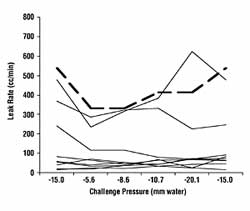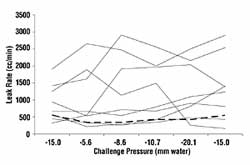Does Increasing Breathing Resistance Increase Respirator Faceseal Leakage?
It is likely that changes in leak size affect faceseal leakage to a greater extent than changes in pressure drop across the leak.
- By Larry L. Janssen, CIH, Bob Weber, CIH
- Jan 01, 2006
 MANY
MANYrespirator program managers have been taught that respirator faceseal leakage increases directly with increased breathing resistance. If this were true, an increase in breathing resistance (pressure drop) because a particle filter has become loaded with a solid aerosol (clogging) would be expected to increase the wearer's contaminant exposure via increased faceseal leakage. Additionally, a very efficient air purifying element with relatively high pressure drop might offer less overall protection than a less efficient air purifying element with lower pressure drop, again because of increased faceseal leakage. Several authors have used either calculations based on theoretical leaks or measurements made with fixed, artificial leaks to show a positive correlation between pressure drop and leak rate.
1-3
Two studies have evaluated the possibility of faceseal leakage increasing with pressure drop on people wearing respirators with actual (rather than artificially induced) leaks.4,5 This article will summarize the larger, more recent study.5
Procedures
Leak rate measurements on 33 human subjects were made with a FitTester 3000 (OHD, Birmingham, Ala.). This is a quantitative fit testing (QNFT) instrument that requires an elastomeric respirator to be sealed with special manifolds while the subject holds his/her breath. The instrument then draws air from within the facepiece until a fixed negative pressure is obtained.
While maintaining this fixed negative pressure, the volumetric rate at which air leaks through the facepiece-to-face seal is measured. When used for QNFT, a fit factor is calculated by dividing a "modeled breathing rate" by the measured leak rate. The modeled breathing rate represents the total amount of air a respirator wearer would inhale per minute, i.e., the user's minute volume.
Both the modeled breathing rate and the amount of negative pressure (corresponding to breathing resistance) the FitTester generates can be varied to represent a variety of respirator use conditions. For this study, each of these variables was adjusted as necessary to approximate several breathing resistances: -5.6, -8.6, -10.7 and -20.1 mm of water. Measurements were also made at the settings required by the Occupational Safety and Health Administration6 for QNFT before and after the other measurements. This allowed the subjects' fits to be classified as acceptable (fit factor greater than 100) or unacceptable (fit factor less than 100).
Fit was classified as adequate only if both of a subject's "OSHA" fit factors (before and after the other measurements) were greater than 100. This criterion was used because it was deemed to represent an adequately stable fit.
Results and Discussion
Figures 1 and 2 show the measured leak rates for two subgroups of test subjects with adequate and inadequate fits, respectively. Inspection of Figure 1 reveals that subjects with adequate fit did not experience increasing faceseal leakage with increasing pressure drop. For most of these subjects, leak patterns were essentially flat and are superimposed on one another near the bottom of the figure.
Only one subject appeared to show a slight tendency for leakage to increase with pressure drop. In contrast, one subject's leak rate appeared to decrease with increasing pressure drop. In each of these cases, the changes are small. Because these changes are small and contradict one another, it is likely that both are due to small changes in fit over the course of the test sequence.
It is also interesting to note that, except for three measurements, all of the fit factors on Figures 1 and 2 are above 100. This supports the criterion used to define adequate fit, i.e., the subjects had fits that were stable across all pressure drop settings.
Figure 2 shows that there was no discernible pattern of increased leakage with increased pressure drop for the test subjects with inadequate fit. The curves for the four subjects with the highest initial leak rates in Figure 2 show significant variability in leakage, consistent with a poor, unstable fit. One subject (initial leak rate 567 cc/min) appeared to show a very small increase in leak rate as pressure drop increased. However, the leak rate at -20.1 mm water was less than the leak rate at the initial OSHA setting and only about 15 percent higher than the final OSHA leak rate. It is therefore likely that a change in the fundamental fit of the respirator accounts for the changes in leak rates at the other pressure drop settings.
Therefore, the concept of faceseal leakage increasing with breathing resistance was not supported by this study. It must be realized that the phenomenon of increased flow through an orifice with increased pressure drop is well recognized only for openings of fixed dimensions, such as those created by artificial faceseal leaks. Only one study4 has suggested that this phenomenon may occur with real facepiece-to-face leakage. For this observation to be valid, the leak rate measurements must be made on the same size leak at each pressure drop. However, evidence suggests that actual respirator faceseal leaks are dynamic, changing in both size and shape with time. This has been noted in both laboratory3 and workplace7 testing.
The work of Krishnan, et al.3 is particularly relevant to the present discussion. They used an experimental "dichotomous flow" QNFT instrument to measure faceseal leak rates and calculate "flow fit factors" (FFF). Like the FitTester 3000, the test subjects were required to hold their breath while wearing a half facepiece respirator temporarily sealed with special manifolds. Leak rate measurements were made with subjects holding their heads facing forward, turned upward 45 degrees and turned 45 degrees to the right.
The resulting FFF measurements had coefficients of variation ranging from 5 percent to 49 percent in these static positions. The authors concluded, ". . . even for the same respirator fit there is a high degree of variation in the fit data collected due to fluctuations in the faceseal leak size." Thus, it is likely that changes in leak size affect faceseal leakage to a greater extent than changes in pressure drop across the leak. As such, it is not reasonable to expect leak rates to increase with increased pressure drop for actual faceseal leaks on human subjects. When respirators are properly fitted, these changes in leak size do not adversely affect protection. This is demonstrated by the fact that numerous workplace protection factor studies have shown respirator performance equal to or greater than that expected, i.e., the assigned protection factor.8-11
Conclusions
The concept of increasing breathing resistance causing an increase in respirator facial leakage was not supported by this study. Respirators that met the OSHA criterion for acceptable fit did not exhibit an increase in faceseal leakage with increasing pressure drop. No consistent pattern of change in leak rate was seen on the poor fits. Leakage changed significantly only when fit was so poor that the respirator could not be assigned for use in an actual workplace, i.e., when the fit factor was less than 100.
Based on these findings, increasing pressure drop will not increase faceseal leakage in the workplace if a properly managed respiratory protection program that includes fit testing is in place.
References
1. Campbell, D.L.: The theoretical effect of filter resistance and filter penetration on respirator protection factors. J. Int. Soc. Respir. Prot. 2:198-204 (1984).
2. Myers, W.R., H. Kim and N. Kadrichu: Effect of particle size on assessment of faceseal leakage. J. Int. Soc. Respir. Prot. 9:6-21 (1991).
3. Krishnan, U. K. Willeke, A. Juozaitis, T. Myojo, G. Talaska and R. Shukla: Variation in quantitative respirator fit factors due to fluctuations in leak size during fit testing. Am. Ind. Hyg. Assoc. J. 55:309-314 (1994).
4. Nelson, T.J. and C.E. Colton: The effect of inhalation resistance on facepiece leakage. Am. Ind. Hyg. Assoc. J. 61:102-105 (2000).
5. Janssen, L.L. and R.A. Weber: The effect of pressure drop on respirator faceseal leakage. J. Occ. Env. Hyg. 2: 335-340 (2005).
6. "Respiratory Protection." Code of Federal Regulations. U.S. Government Printing Office, Office of the Federal Register, Washington, DC. Title 29, Section 1910.134. 1999. pp. 402-427.
7. Myers, W.R., Z. Zhuang, T.J. Nelson, S. Sides, and D. Wilmes: Field performance measurements of half-facepiece respirators-study protocol. Am. Ind. Hyg. Assoc. J. 56:765-775 (1995).
8. Myers, W.R., Z. Zhuang, T.J Nelson, S. Sides and D. Wilmes: Field performance measurements of half-facepiece respirators-study protocol. Am. Ind. Hyg. Assoc. J. 56:765-775 (1995).
9. Myers, W. R., Z. Zhuang, T. Nelson: Field performance measurements of half-facepiece respirators--foundry operations. Am. Ind. Hyg. Assoc. J. 57: 166-174 (1996).
This article appeared in the January 2006 issue of Occupational Health & Safety.
This article originally appeared in the January 2006 issue of Occupational Health & Safety.